Review: The 2025 Aston Martin Vantage Is For The Drivers
Not long ago, Aston Martin found itself in a make-or-break point. Throughout the late 2010s, dwindling sales figures and the subsequent burning of cash reserves put the automaker in a dire spot. Things began to change when, in early 2020, it announced that Lawrance Stroll would acquire a 16.7 percent stake in the company, who, alongside additional investors, sought to inject $655 million to keep it from flatlining. Once in control as Executive Chairman, the Canadian billionaire shared his vision: to turn AM into a British Ferrari. Before that goal could even be possible, however, the carmaker had a major decision to make.

Back then, Aston Martin seemed like a company pulled in opposing directions and stretched thin. It had plans to pivot, reimagining the Vanquish as a V6-powered mid-engined supercar. Meanwhile, its current offerings struggled to compete with rivals, as illustrated by slowing sales and shocking second-hand values. Aside from the elegant hooligan that was the 715-horsepower DBS Superleggera, the Vantage, DB11, and DBX had flash but no fire. Would AM scrap its lineup, introducing all-new replacements in the second half of the 2020s, or would it update its current lineup to bring competitive cars to market sooner?
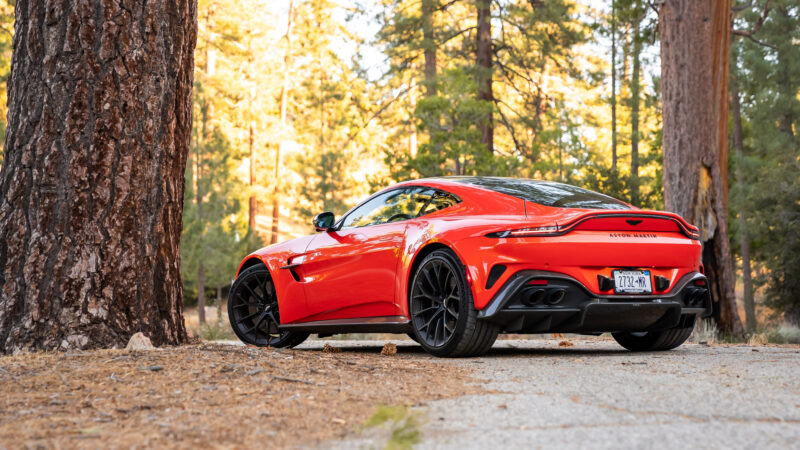
A glance at the 2025 Aston Martin Vantage reveals the chosen path. Like the DB12, it carries over the basic structure underpinning its predecessor. However, its track is 1.2 inches wider, incorporating a thoroughly reworked suspension with Bilstein DTX active dampers. Its interior leaps forward in quality, design, and usability, while power from its 4.0-liter twin-turbocharged V8 swells to 656 hp. Beyond its lengthy list of updates, here’s what you need to know about the new Vantage: it oozes character. From the noise of its burbly engine to its tail-happy nature and thrilling performance, this refresh is not a quick fix. It’s an adrenaline shot straight to the heart.
And it can’t afford to be anything less. The bite-your-knuckles gorgeous Cosmos Orange two-door photographed above costs $291,000, $3,500 destination fee included. However, it starts at $194,500, meaning this particular example wears $96,500 in extras alone, a figure made all the more striking considering the extinct 2023 model asked for $146,986 to start. Although this upmarket push might initially seem avaricious, it’s straight from the Maranello playbook Stroll seems eager to emulate. Take a peak at Ferrari’s Q3 2024 earnings, and you’ll see increased earnings despite fewer shipments. The formula is simple: produce and sell fewer cars at higher prices, especially ones loaded with high-margin extras.

Of course, selling a minimally revised product at substantially higher prices is a recipe for failure, and thankfully, not one that applies to the latest Aston Martin Vantage. Although it may ride on old bones, they’ve been coated in Adamantium. Thanks to targeted reinforcements, the Vantage is more torsionally rigid, while a focus on shifting weight away from its nose grants it an ideal 50:50 distribution. Its Bilstein DTX adaptive dampers, similar to what you’ll find in the DB12 and the Vanquish, offer greater bandwidth between drive modes. It can thus be both firmer and more compliant when necessary.
Make no mistake, though. While the Vantage can double as a grand tourer, given its usable storage space and compliant ride, it will always be a sports car first. Whereas its predecessor was a handful, mainly in unsatisfying ways given its sloppy handling (the short-lived F1 Edition made improvements, but not nearly enough), the new car is a step forward in every discernable way.

Point its nose towards your favorite back road, and the Aston Martin Vantage will reward you with 911 Turbo S levels of grip and stability. It combines a broader track, a new electronic differential, and bespoke Michelin Pilot S 5 rubber. Unlike the Porsche, however, the Vantage isn’t satisfied with tackling a road as quickly as possible. It’s eager to mess around. With enough traction control settings for a 747 cockpit to manage, it allows you to dial back its stability systems in minute increments.
Exciting the rear takes no more than a throttle blip. Turn it off, and the Vantage will throw itself sideways anywhere upon request. Unlike its predecessor, however, you won’t find yourself white-knuckling the wheel, taking big swings to settle it. Instead, thanks to a more communicative chassis, you can intuitively feel as it lets go, and thanks to quick and precise steering, you can effortlessly neutralize a slide. With 656 hp on tap, powering through is always more tempting.

Its 4.0-liter twin-turbocharged V8, although heavily modified by Aston Martin, still has Affalterbach origins. Yet, while it produced 503 hp in 2023, higher compression ratios, new turbochargers, and improved cooling elements allow its output to climb to the full 656 hp of today. Its torque figure also rises to 590 pound-feet, sent to the back wheels via the ubiquitous ZF eight-speed automatic.
Its claimed 3.4-second time to 60 mph feels vastly underrated, although putting that much power down via the rear tires alone is no easy feat. Still, the jump in performance is staggering, especially for a car with a relatively short wheelbase. It’s a brute in a posh suit, and all the better for it.

And what a suit it is. Although its rear end is more than familiar, given that it essentially carries over the existing tail lights, the front clip receives a much-needed facelift. Like its performance, the Aston Martin Vantage finally gets the good looks it always deserved. Telling you it’s a stunning thing is practically superfluous. Aside from those who get a kick from being contrarians, I doubt you’ll find anyone who sees it differently. It has a killer stance, the right mix of sporty and elegant, and, in this tester’s case, a tasteful optional aero package.
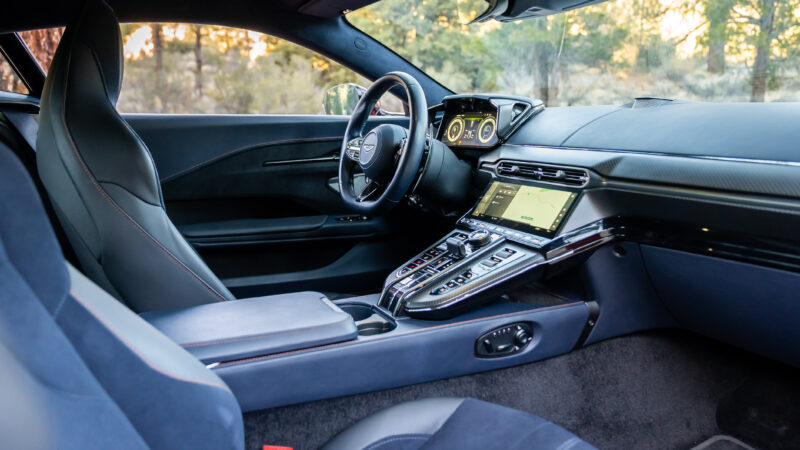
Stepping in generates a similar feeling. Its cabin is perhaps the area with the most impactful improvement. From its digital cluster to its wide central infotainment screen, now with AppleCarplay and Android Auto connectivity, the Vantage is more than just competitive. Additionally, there’s a greater level of flexibility in terms of personalization. Still, its driving position is perfect, allowing you to sit low and snug, while its leather-wrapped steering wheel is actually wheel-shaped, no longer an odd squircle.
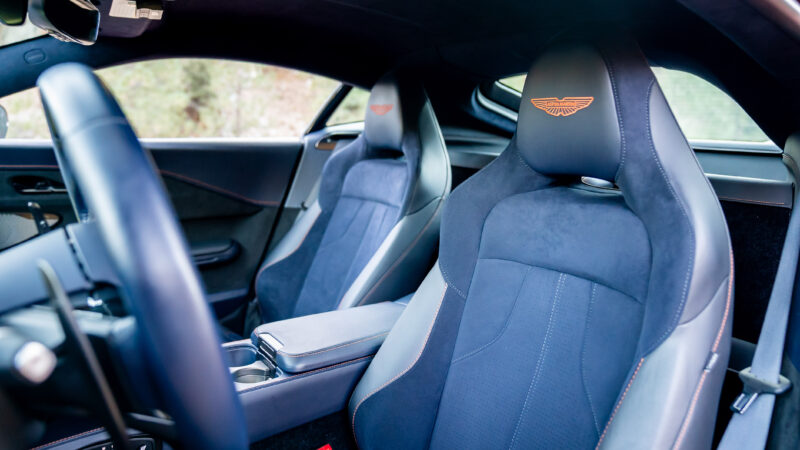
Like the DB12, the latest Aston Martin Vantage represents a monumental upgrade over its predecessor. However, it might be tempting to align the Vantage with its GT sibling, given how much hardware they share, but these are vastly different animals. While the 671-hp DB12 is more powerful, its longer wheelbase and more restrained calibration make it a far more docile and approachable machine. For most people, it’ll feel like the more enjoyable of the pair.
Therein lies the Vantage’s one central asterisk. To experience just how good it is, you have to be willing to fling it around like the sports car it is. Tackling a twisty road at full speed like a Turbo S is rewarding, but the Aston’s magic lies beyond its grip limits. This is a car for the drivers.

Whether this newly defined persona, made up of a significant power increase, a refined aesthetic, and a competitive interior, will be enough to compel buyers to shell out large sums like the $291,000 this tester commands remains to be seen. However, before Aston Martin ever reaches its goal of becoming a British Ferrari, it needs a strong product line. And as the Vantage proves, it’s off to a strong start.
First Drive: The 2025 Rolls-Royce Ghost Series II
by Gabriel Vega
in Reviews

Here’s a helpful TL;DR. The Rolls-Royce Ghost Series II is not just a luxury car; view it solely through that lens, and you’ll miss its true intentions. Developed alongside the expansion of the marque’s customization arm, the aptly named “Bespoke,” the Ghost Series II has evolved from an ultra-lux sedan into a $500,000 platform for personalization and self-expression.
Contrary to how it sounds, that last line isn’t the work of RR’s marketing department. Ask Phil Fabre de la Grange, Head of Bespoke, and he’ll tell you that every vehicle that rolls out of Goodwood incorporates work by his team of specialized craftspeople and designers. On average, 10 percent of the total purchase price goes to these unique touches. For a car that often stickers well beyond $500,000, that’s no small feat. As demonstrated by the Phantom Syntopia, a more elaborate commission can easily exceed seven figures.

This shift in not just how ultra-luxury machines are made but what they represent informs the Series II’s driving spirit. It is, after all, mechanically unchanged. It all carries over, ranging from its 6.75-liter V12 engine to its world-class suspension and geo-tracked gear shifts. More on that last one later. Instead, like the Cullinan Series II, the new Ghost and its Black Badge twin incorporate an updated tech suite, à la Spectre, styling that strays from RR’s old-timey aesthetic and, crucially, truly limitless customization options. This isn’t a refresh; it’s a philosophical shift.
The roads surrounding Aix-en-Provence in the South of France aren’t particularly Rolls-Royce-friendly. Winding, narrow countryside lanes snake through small towns with ancient brick buildings just millimeters off your mirrors. Occasionally, you’ll roll past a historic winery previously occupied by the Romans, only to duck out of a local’s way as they barrel towards you, their arm hanging out the window with a lit cigarette in hand. Still, the scenery is stunning, with vast rock formations puncturing through a dense sea of luscious trees. The Mediterranean sits a stone’s throw to the south, with Monaco closely to the east.
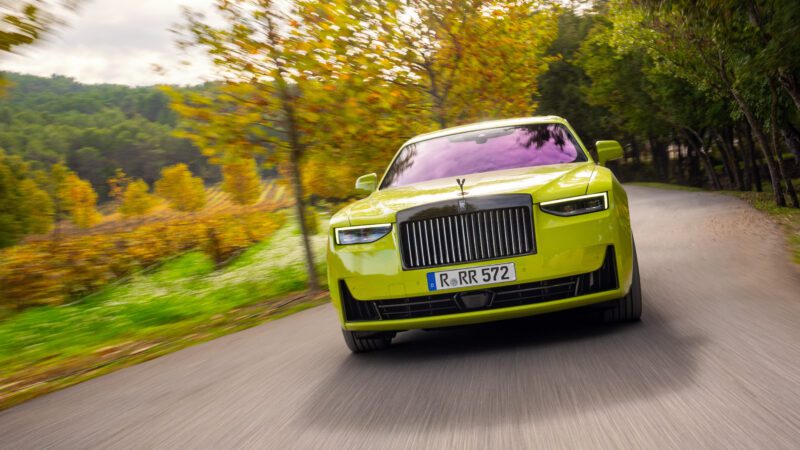
As counterintuitive as it sounds, this pre-set drive route’s focus on gorgeous views rather than serving up more technical roads aligns with what the Rolls-Royce Ghost Series II is ultimately going for. Short of a Phantom, it’s as refined and isolated as current technologies allow, and as the Spectre demonstrates, the next step up requires batteries. As such, Goodwood’s decision to leave its oily bits alone makes sense. Its 6.75-liter twin-turbocharged V12 develops the same 563 horsepower and 627 pound-feet it has since the 2020 introduction of the Ghost’s second generation.
Its Black Badge twin pushes those figures up to 591 hp and 664 lb-ft, although given that they’re propelling a 5,628-pound body, the resulting 4.6-second sprint to 60 mph is identical to the “standard” model’s. Still, the BB’s added sport mode, labeled on the column-mounted shifter simply as “Low,” sharpens its eight-speed auto’s shifts and moderately quickens its throttle response. As such, it feels slightly more responsive than you’d traditionally expect from a Rolls, generating a stronger sensation of speed, even if the stats demonstrate that you’re no quicker off the line.
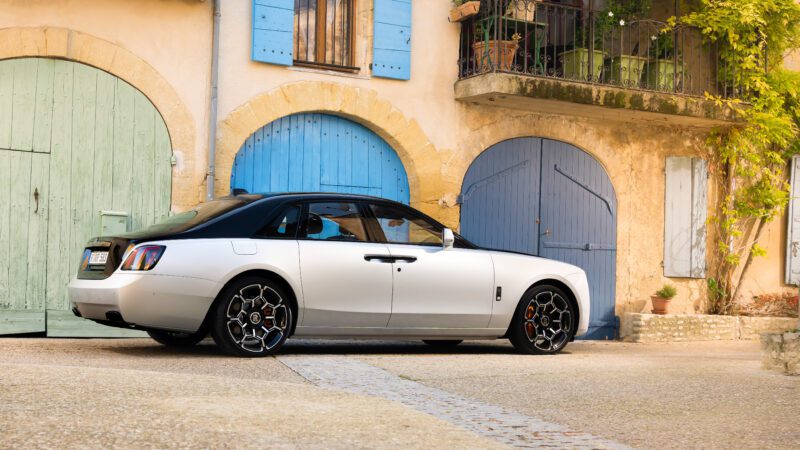
Given that the Ghost rides on the Architecture of a Luxury platform like the Cullinan and the Phantom, it benefits from the same world-class suspension components. Its Flagbearer system uses cameras that scan the road ahead. It then feeds that data to its Planar air suspension, which actively adjusts and self-levels to ensure no imperfections spoil the ride. Rolls even employs satellites to geo-locate its cars, supplying their eight-speed autos with information about any upcoming bends to prepare the perfect shift. The only change introduced for the Series II is a suspension software update to account for larger 22-inch wheels.
Short of a Phantom, the Ghost is the most comfortable and refined internal combustion car money can buy, but you already knew that. Here’s where its evolution begins to take shape, and it all revolves around Bespoke.
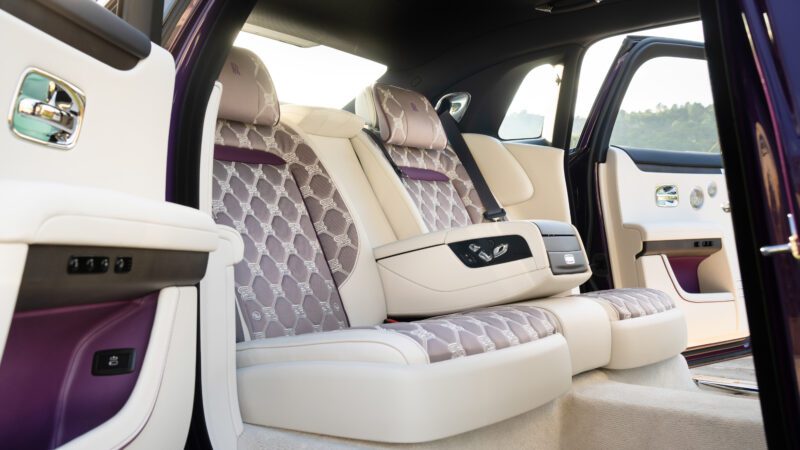
Since introducing the Phantom Series II in 2022, Goodwood’s customization arm has undertaken progressively more elaborate commissions, ranging from the Phantom Scintilla to hand-built limited editions like the $28 million Boat Tail. Like the Cullinan Series II, the new Ghost benefits from an expanded list of available finishes and textures. Materials like Duality Twill introduce a cloth interior option comprising over 2.2 million stitches and over 11 miles of Bamboo fabric. Placed Perforation allows buyers to commission intricate designs consisting of over 100,000 tiny perforations for leather-wrapped cabins.

Those extras, however, only scratch the surface of what Bespoke can now do. I stopped at Château La Coste for a car swap and a chat with de la Grange, in which he explained just how customizable the Rolls-Royce Ghost Series II aims to be. Barring the car’s safety elements, which can’t be modified for regulatory reasons, there’s practically no commission Bespoke won’t seriously consider. As we chatted, he pointed to a hand-painted dashboard showcasing the ocean transitioning into a full-on beach. This single piece took around six months to develop and execute. Its cost is somewhere in the high five-figure range.

Across the room, Audrey Fasquelle, a woodworking specialist in the Interior Surface Centre, slowly carved a flower into a wooden dash. She explained that, like most intricate commissions, this piece will take her months to complete. This includes an extensive revision process in which all visible flaws must be corrected. This level of personalization and attention to detail can be applied to practically every component, resulting in near-limitless options. According to de la Grange, that’s precisely what RR wants its customers to do: to utilize these capabilities to commission truly unique cars.
However, the Series II’s extras go beyond the physical, as it now incorporates the digital cluster, a high-res central display, and a glass-paneled dashboard that debuted in the Spectre. As such, its digitized instruments can now adopt a variable color scheme that complements the rest of the vehicle, while a small Spirit of Ecstacy statue sits enclosed below an analog clock. Its broadened tech suite now offers Bespoke Audio, which incorporates exciters placed directly in the headliner and is available alongside the Starlight option.
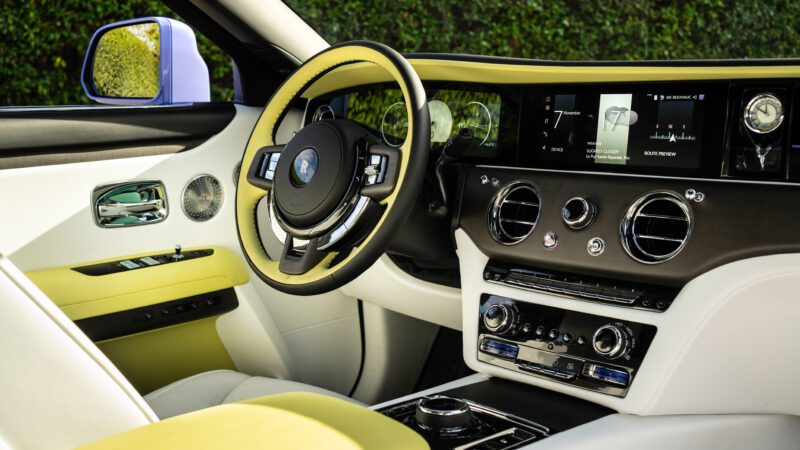
Back on the road in the Black Badge, it’s clear that with the introduction of the Rolls-Royce Ghost Series II, the marque went to great lengths to differentiate its sportier offering. In the pre-facelift models, the BB had to distinguish itself with its darkened trim and exposed-carbon wheelset.
While this updated version improves those elements with new wheel designs, it incorporates, for the first time, black door handles. This plays alongside more angular lower front fascia trim, which, by lacking any bright chromework, also provides a nice contrast against the body color. These updates work in tandem with the updates introduced for the Series II, like its new headlights, grille, and tail lights. The result is a car that is slightly modernized, deviating from RR’s old-timey aesthetic. This move coincides with a customer base that gets younger every year.
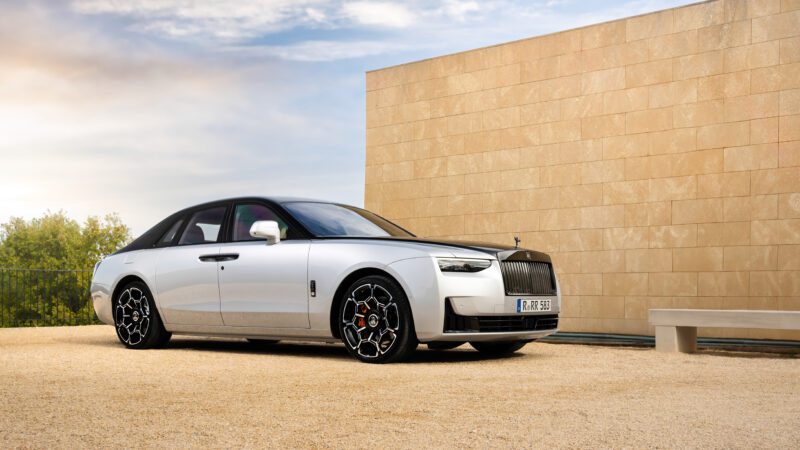
Pricing for the Rolls-Royce Ghost Series II is challenging to pin down. While it starts at $355,000, with the Black Badge jumping to $420,000, I’ve yet to drive one that costs less than $500,000 once all options are factored in.
This disparity is less surprising when considering the Series II’s philosophical shift. Working from the strong base of the second-gen Ghost, Rolls-Royce has left the mechanicals untouched and focused on offering a nearly endless list of options boxes, as it sees a growing number of customers willing to tick them.
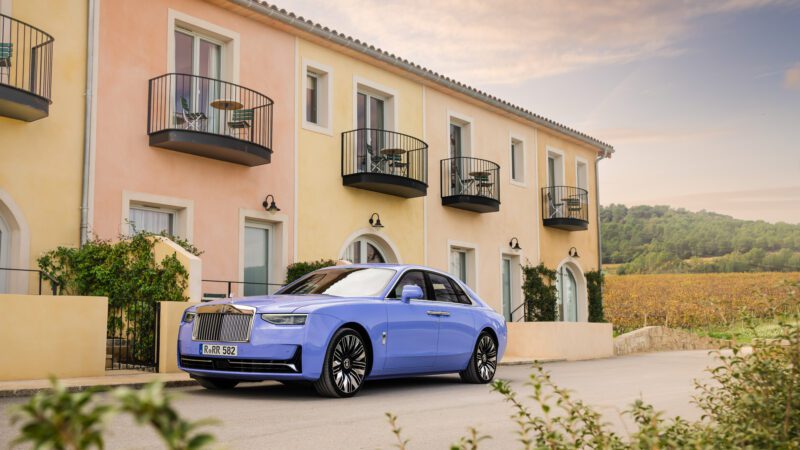
Beyond Goodwood, the world of ultra-lux sedans has made considerable leaps in the last decade, with multiple excellent options as this niche segment continues to expand. However, it’s quickly becoming apparent that batteries must come into play to reach the next level of refinement and isolation.
As such, the Ghost Series II evolves beyond a luxurious sedan into a platform for personalization and self-expression because it has to. Whether its customers are traversing narrow roads in the south of France or cruising anywhere else in the world, Rolls-Royce sees the future of the ultra-lux space characterized by experiences that are truly bespoke.
We Take The Porsche 911 Dakar For A Day At The Track
by Gabriel Vega
in Reviews
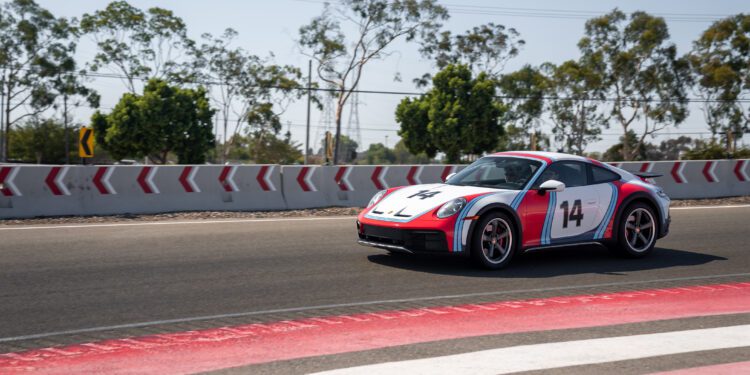
You couldn’t miss it if you tried. Its lifted stance, widened fenders, and Fuchs-style five-spoke wheels make the Porsche 911 Dakar instantly recognizable. Adorn it with one of a handful of available liveries, and this limited production model, which began its development as a Carrera 4 GTS, makes an even stronger case for why you should shell out the $223,450 it demands.
Not that you could, though, even if you had the cash. With production restricted to just 2,500 units, the entire lot has long since sold. Meanwhile, peering at pre-owned values reveals asking prices well north of $300,000. As is typical of Porsche’s limited-run models, it’s likely already sold out by the time you’ve heard of it.
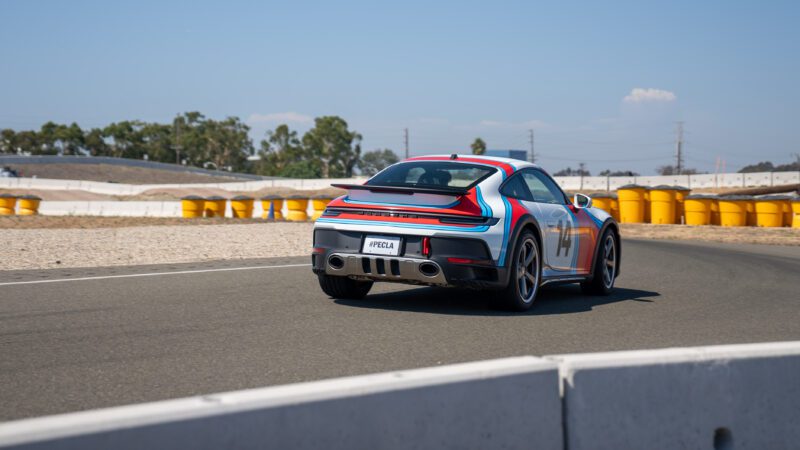
Why bother driving it then, you ask. The Dakar’s persona, like much of the 911 range, is multifaceted. While its marketing materials see it photographed in desolate places or tackling sandy dunes, the reality is that most will be stashed in collections by speculators or relegated to a life of pounding asphalt. Like the Lamborghini Huracan Sterrato, only a handful will ever be driven as intended. And so, its engineers haven’t built it to be an uncompromising off-roader. This is still a 911, after all, one that promises to be just as good on the trails as off them.
I’ll admit I’m pushing it to the other extreme here. When Porsche floated the idea of driving the Dakar for the first time at its Experience Center in Los Angeles rather than on the street or a carefully selected off-road course, I jumped at the opportunity. There’s a method to the madness, however. During the LA Auto Show in 2022, as I stood at a media preview for the Dakar, the carmaker sneakily mentioned that it’s as quick around the Nurburgring as a 996-generation 911 GT3, a fact that’s stuck with me since.
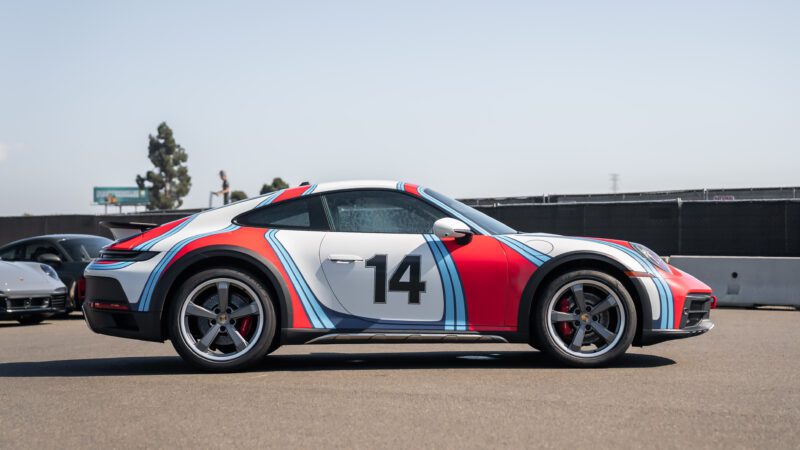
The Porsche Experience Center is an expansive facility in Carson, CA, less than 20 minutes from Los Angeles International Airport. It’s one of two PECs in the US; the first opened in Atlanta, Georgia, the home of the carmaker’s North American headquarters. In LA, the marque offers a driving experience in nearly every car it makes, ranging from a Cayenne S to the latest GT3 RS. Today, however, I’m here for the 90-minute session in the Dakar, an experience that’ll set you back $1,025.
Once checked in, you step past rows of preserved classics, a world-class workshop, a small cafe, and a full restaurant that makes up much of the building’s second floor. There’s plenty to do and even more to look at. Still, I was eager to get behind the wheel, so after a quick coffee, I met with the driving coach who would ride shotgun for the experience and stepped out to the PEC’s staging area.
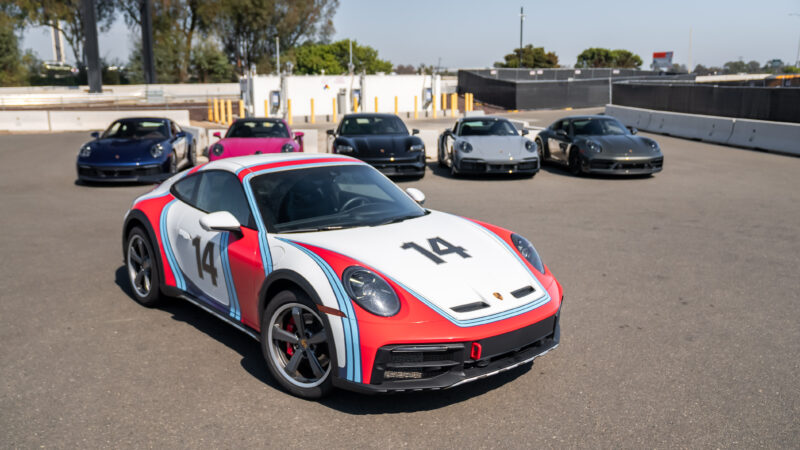
The Porsche 911 Dakar I’d be driving sat amongst a row of 718 Caymans, 911s, and Tacans of all flavors, wearing an optional Rally 1978 livery, a nod to the 911 SC Group 4 car Björn Waldegård drove in the East African Safari Rally that year. It sports a slick top devoid of a sunroof or any of the dozens of accessories available for it. Crucially for a day on the track, the staff at PEC had wrapped its five-spoke wheels with Pirelli P Zero summer tires.
While I understand the reasoning behind the decision to shelve its standard Pirelli Scorpion All Terrain Plus rubber, I was slightly disappointed. After all, Porsche developed the Dakar to be an off-roader first. While its options list does offer sets of summers and winters as extras, I wondered how much of its driving experience would now mirror that of the Carrera 4 GTS upon which it’s based. I sunk into its standard carbon fiber bucket seat fired up its flat-six and slowly crept onto the track.
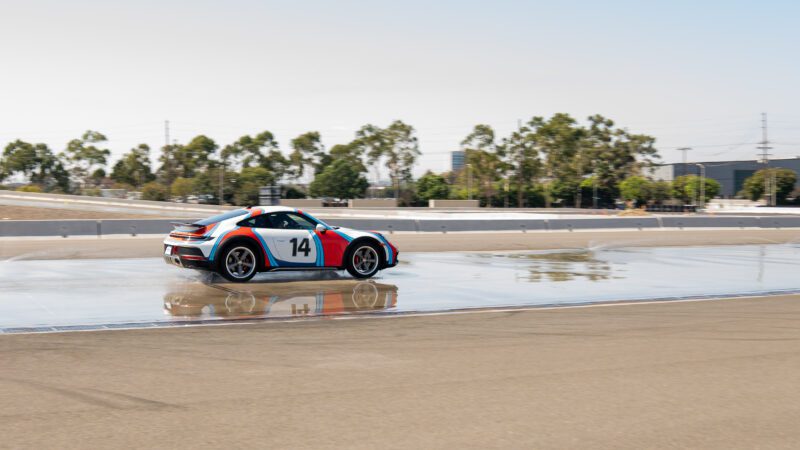
The Porsche 911 Dakar experience may only be 90 minutes long but has a choose-your-own-adventure feel. The crown jewel of the PEC is its 1.3-mile handling circuit. However, there are low-friction courses, a giant skidpad equipped with sprinklers to ensure you’re instantly sideways, a kick plat exercise to test your reaction times, and an off-road circuit. The latter is reserved for SUVs, so this is purely a track day.
We kicked off with a few runs on the kick plate, which, as its name suggests, uses a shifting metal panel that swings a car’s rear randomly to the left or right, simulating a hydroplaning event at highway speeds. It’s simultaneously a great test of your reaction times. Move too slowly, and you’ll complete a full loop before you even know what happened. Catch the initial slide, however, and the all-wheel-drive Dakar recovers with only a twitch of its back end. I suspect that something mid-engined, like a GT4 RS, would be more of a handful.
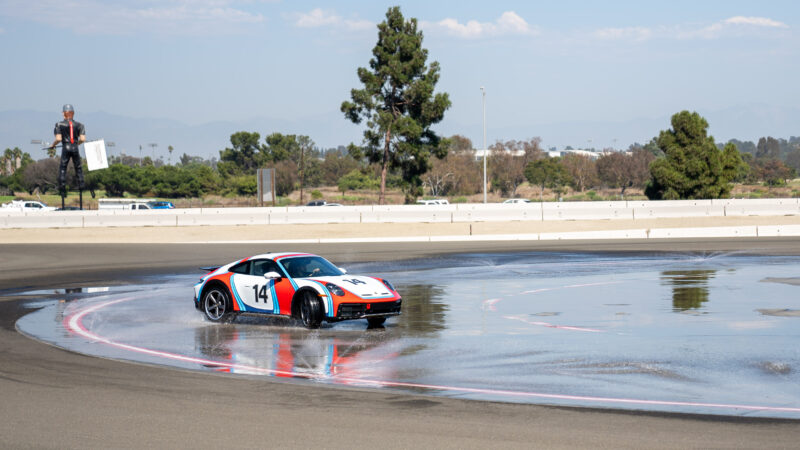
The skidpad and the most challenging part of the experience came next. With sprinklers raining on the surface, the giant donut-shaped course was ready for slides. I, however, was not. As I picked up speed on the course, my foot slowly came off the throttle while I tucked the nose towards the center of the track. I floored it and counter-steered to catch the slide. I did it precisely as I’ve done in countless rear-drive BMW M cars and as I did on an ice track with rear-drive V8 Maseratis. What I hadn’t done is remember that the Dakar is all-wheel drive.
Initiating proved easy enough; however, holding it was much more challenging. The Porsche 911 Dakar can hold extreme angles as it glides across a track sideways. It requires more throttle than steering input, and once in the drift, total commitment to the throttle to keep it going. Even as you feel you’re a split second away from looping it, it demands a steady feed of power. Grant its wish, and you’ll be rewarded with controllable drifts that don’t end with you facing backward. All it takes is a bit of mental rewiring.
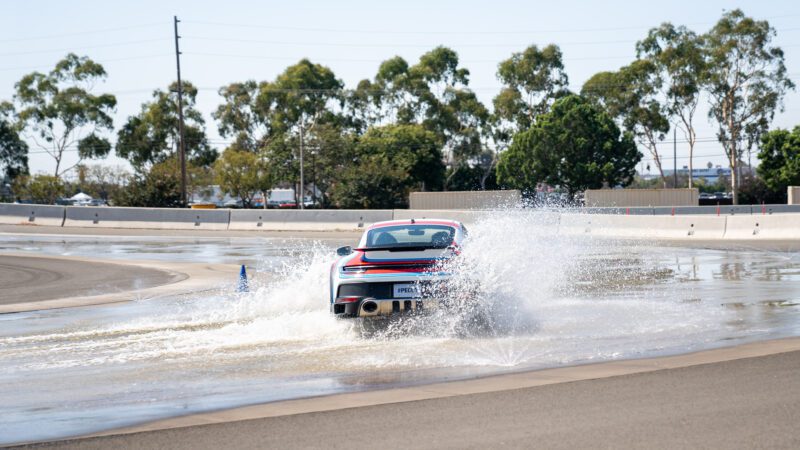
Before we pulled onto the 1.3-mile circuit, my instructor directed me to a short autocross course to familiarize myself with the Dakar’s performance on a dry surface. Within minutes, however, it was time for some citing laps.
The track experience kicks off from the right seat as the instructor gives you a tour of the track, pointing out braking zones and demonstrating the ideal racing line. Now, you also become aware of the many other cars you share the circuit with. As you pull out of a corner, you may see a GT4 RS creeping up from behind or catch up to a Carrera S on a cool-down lap. There’s more to the experience than just the track itself, and the instructor is constantly monitoring traffic to ensure everyone keeps their distance and passes only on designated zones.
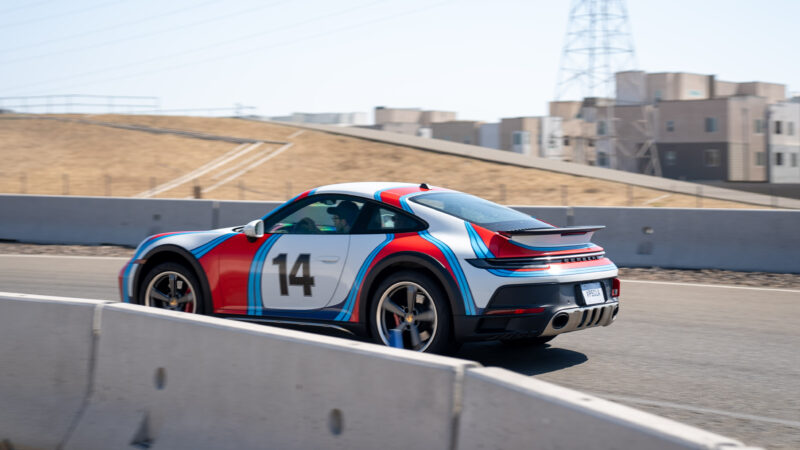
Back in the carbon buckets, I finally felt like I was getting to grips with the Dakar. Although much of it feels familiar with its cabin, GT sports wheel, and excellent visibility, some differences immediately emerge. For one, its stance. The Porsche 911 Dakar sits 1.9 inches taller than a Carrera equipped with a sports suspension. A standard lift system raises it a further 1.2 inches, a stature it maintains until you cross 105 mph.
Its hood, a gift from the GT3, and rear spoiler are carbon-fiber-reinforced plastic. A combo of lightweight glass and a lighter battery keeps its weight at 3,552 pounds. That’s 16 lb heavier than a 911 Carrera 4 GTS equipped with a PDK transmission. Yet despite weighing roughly the same, the Dakar sports additional underbody protection and a redesigned intake system.
The oily bits carry over from the Carrera 4 GTS largely untouched, with its twin-turbocharged 3.0-liter flat-six developing the same 473 horsepower and 420 pound-feet of torque output. It’ll sprint to 60 mph in 3.2 seconds and top out at 149 mph, with power going to all four wheels via an eight-speed PDK.
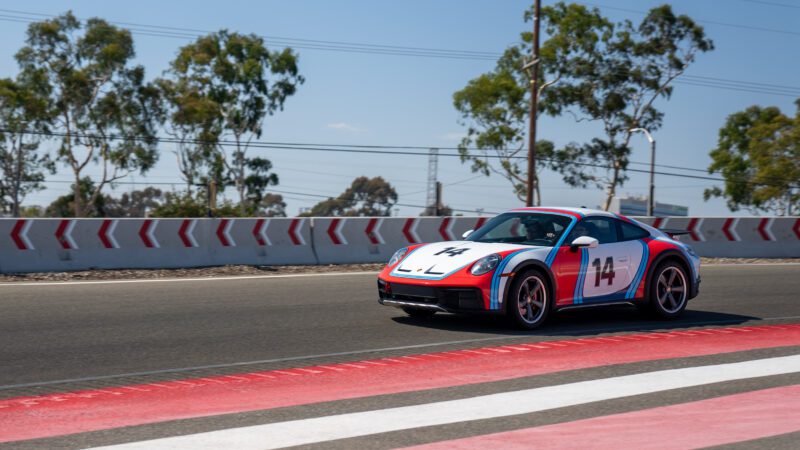
Picking up the pace as I learned the 1.3-mile track, I felt myself settling nicely into a rhythm behind the wheel. This may come as a shock, but equipped with summer tires, the Dakar drives like, well, a 911. Despite the lift, its handling is confident, and thanks to the Pirelli rubber, it delivers the grip you’d expect from a Carrera 4 GTS. I’d love to tell you that it leaned in the bends or felt drastically different, but that wasn’t the case. Even under hard braking zones, the nose never dipped considerably, nor did the back squat while shooting out the other side.
As anti-climatic as this revelation is, that also seems to be the Dakar’s secret sauce. Although Porsche developed it with off-roading in mind, I can’t help but remember the places where these cars actually live. Building a compelling off-roader is one thing, but its appeal would be limited if it only excels in that setting.
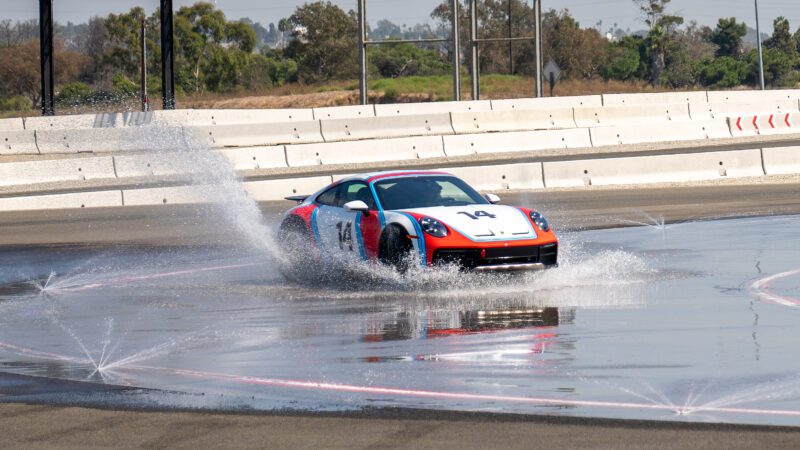
Yet that makes Dakar unique; it doesn’t ask you to choose. You can have the benefits of added ground clearance, a great ride, and the cool factor that is its unique aesthetic without sacrificing anything. Whether you go off-roading or, for whatever reason, you decide to take it to a track, it’s still as versatile as a 911 should be.



